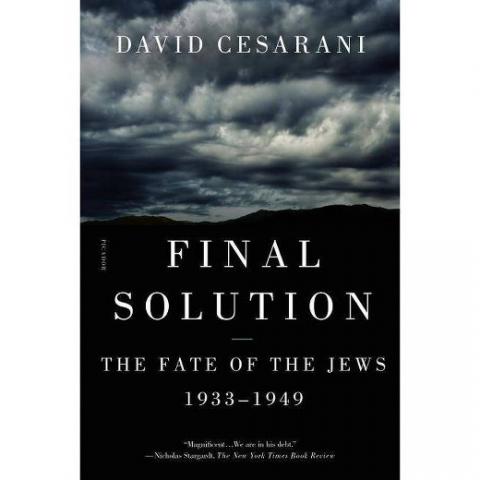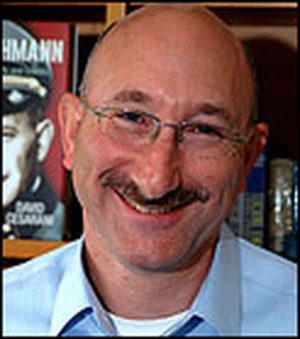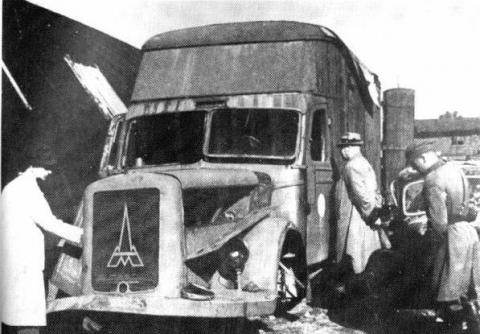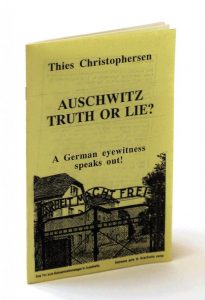Are we nearing the End of Auschwitz?
“Cesarani concedes there is a yawning gulf between popular understanding of this history and current scholarship.”

David Cesarani’s final book detours around many of the extreme claims that make up the story of Auschwitz and have been pushed onto the popular mind.
By Carolyn Yeager
Is the obsession to do away with Holocaust Denial putting Holocaust Belief on the chopping block? So often it’s been the case that attempts to condemn ‘Holocaust denial’ only lead to exposing more of the very real and insolvable problems inherent in Holocaust belief.
A case in point is English historian David Cesarani’s 1000 page magnum opus that was published in 2016, titled Final Solution: The Fate of the Jews 1933-1949. The book comes across as Cesarani’s effort to ‘save the Holocaust’ for the Jews since, as a serious historian he is familiar enough with revisionist literature to know that its arguments cannot be disputed with standard holocaustian “scholarship.” So many mistakes were made early on. So much outlandish tale-telling was given the stamp of approval for the simple reason the Allies wanted to convict the Nazis of war crimes worthy of death at the Nuremberg Tribunal of Major War Criminals in 1946. Yes, these men were labeled war criminals before their trial even took place. And they had to be put to death to prevent them from later talking or writing about what really happened.
Cesarani is sensitive to how, as a historian who values his reputation, he can present a case that supports the Holocaust without endorsing its associated myths that are not even in the realm of the possible. Such myths as that 6,000,000 Jews were killed and cremated in 3 years time (1942-44) by a relatively small number of German fanatics. Also the belief that killing Jews was more important to these German fanatics than winning the war, and that they had planned for years how to make Germany and Europe Juden-free. David Cesarani doesn’t believe any of this.
But he does believe, or pretend to believe that 4,000,000 Jews were killed; he does believe that “Nazism”/antisemitism is a scourge for which it’s perfectly fine to imprison people; and he most certainly believes in Zionism, and in addition the right of Jews to live anywhere they wish outside of Israel without fear or harm.
Cesarani was born in London, an only child of Jewish parents, who after graduating from Queens’ College, Cambridge, got a master’s degree in Jewish history at Columbia in New York. There he worked closely with Judaism scholar Arthur Hertzberg. Later at Oxford University, his doctorate dissertation was an analysis of the history of the Jews in England. Before Cambridge, he spent a year in Israel in a kibbutz, where he had some unpleasant realizations about the unethical behavior of Jews toward Palestinians.
 Cesarani looks like an antisemitic caricature of a Jew! (see left) His outlandishly large nose brings to mind one of those fake noses attached to a pair of fake glasses and maybe a little moustache underneath, meant as jokes, that I remember from my youth. This is evidence to me of his loyalty to and/or pride in his race that he never felt compelled to have plastic surgery done to improve his cartoonish face. He’s okay with looking like a Jew’s Jew, instantly recognizable.
Cesarani looks like an antisemitic caricature of a Jew! (see left) His outlandishly large nose brings to mind one of those fake noses attached to a pair of fake glasses and maybe a little moustache underneath, meant as jokes, that I remember from my youth. This is evidence to me of his loyalty to and/or pride in his race that he never felt compelled to have plastic surgery done to improve his cartoonish face. He’s okay with looking like a Jew’s Jew, instantly recognizable.
Keeping all that in mind, we can ask how Cesarani handles the questionable claims of the traditional Holocaust narrative.
Yawning gulf
In his Introduction to Final Solution, from which I will draw for this article, Cesarani concedes “there is a yawning gulf” between popular understanding of this history and current scholarship on the subject. He explains:
This is hardly surprising … given that most people’s knowledge comes from novels, films, or earnest but ill-informed lessons at school, which frequently rely on novels for young adults or their filmic versions.
And also:
These efforts are subordinate to extraneous agendas, be it the desire to cultivate national identity … [or] to combat anti-Semitism, racism, homophobia. Some lazily draw on an outdated body of research … while others … downplay inconvenient aspects of the newer findings.
You couldn’t find a clearer statement that the popular understanding of Holocaust believers, as it continues to be presented by Jewish-and-globalist-controlled news outlets and politically-oriented magazines and academic journals, is increasingly being recognized as insufficient explanation for the massive murder spree that we are told we must believe took place in those three wartime years. Cesarani, it seems to me, believes the only way forward is to divert attention to a different set of facts than the number of dead Jews and in what manner they were killed —and to focus instead on Jewish suffering from forms of antisemitism that were unleashed by Adolf Hitler’s racist regime and ambitious war aims. In other words, they were almost a form of collateral damage rather than a planned extermination!
An example of this is in his treatment of the 6,000,000 number. He uses generalized numbers and never speaks of an overall total. He estimates that 1,500,000 Jews were shot on the eastern front (by the Einsatzgruppen and other police units); 900,000 to 960,000 were murdered at Auschwitz; 1,700,000 were killed in the Aktion Reinhard (sic, should be Reinhardt) camps, and 97,000 at Chelmno.
[The USHMM estimates 177,000 were killed at Chelmno, with no guarantee of accuracy. This disclaimer goes for everything on their website. Yet they are recognized as “authorities” on the Holocaust. That figure probably comes from the West German Chelmno trials of 1962-65 when the prosecution ambitiously laid charges for at least 180,000 victims.]
These four numbers given by Cesarani add up to 4,257,000 but he never adds them up in his book. It certainly looks like he is avoiding the 6 million number altogether in what is considered to be his magnum opus, which he completed just before his untimely death from cancer in 2015. CODOH [Committee for Open Debate on the Holocaust ] reviewer Panagiotis Heliotis wrote that Final Solution may be seen as the new standard version of Holocaust historiography, which suggests that the 6,000,000 number may be gone for good. Instead, the way to go is to “focus on the numbers piecemeal and avoid totals,” Panagiotis wrote.
Auschwitz is the emotional center of the Holocaust
Cesarani also concedes in his Introduction that only Auschwitz and Birkenau have the emotional impact necessary to cause/generate belief:
[…] the emotional charge that imprints the historical data on the mind is inevitably shaped by physically witnessing this one site. Notwithstanding the intense preparation, the other locations where most Jews suffered, died, and were done to death remain distant.
In other words, without Auschwitz, can we still have the Holocaust as we know it? Auschwitz is the emotional center of the Holocaust. No matter how much effort is made to move or to expand it elsewhere—to the so-called “killing fields” of western Russia where no mass graves of Jews have ever been shown to the world, or to the four so-called Aktion Reinhardt camps of eastern Poland where there is nothing to be seen but empty fields and a few meaningless monuments—only Auschwitz, tawdry and fraudulent though it is, gives a sense of reality to the legend.
Holocaust well past its “sell-by date”
Cesarani even reappraises the usefulness of the term “Holocaust” for what Israel calls the “Shoah”—preferred because it is a Hebrew word that automatically refers to Jews only. He went so far as to write that the term Holocaust “arguably is well past its sell-by date.”
This is not due to the politicization of the word and arguments over what it means, although these are certainly good enough reasons to retire it.
It has become an article of faith that The Holocaust involved the systematic use of state power, modern bureaucratic methods, scientific thinking, and killing methods adapted from industrial production systems. For example, the website of the Holocaust Memorial Day Trust […] states that “Between 1941 and 1945, the Nazis attempted to annihilate all of Europe’s Jews. This systematic and planned attempt to murder European Jewry is known as the Holocaust.”
Instead, Cesarani “contests whether the National Socialist anti-Jewish policy was systematic, consistent or even premeditated.” For Cesarani, NS policymaking “lacked purposefulness.”
There was no overall, centralized, coherent policy or practice until late 1938. While there may have been a broad anti-Semitic consensus within the movement and throughout the institutions of government … this does not mean that one thing led to another logically, necessarily, or even deliberately.
He even called the war against the Jews “a sideshow” of WWII that “was ill-planned, under-funded, and carried through haphazardly at breakneck speed.” (p. 459)
What did happen occurred in fits and starts. He wrote: “The Jews were perceived as a valuable resource when the shortage of labor became acute.” “Military failure created a resource crisis for the German army and the home front—there was not enough food for both.” “The course of the war rather than decisions within the framework of anti-Jewish policy triggered the descent into a Europe-wide genocide.”
Antisemitism gone wild?
Cesarani’s unwillingness to fully endorse the standard narrative is a real advance for revisionists, for we already know that the Holocaust as popularly presented is a great mirage. When we actually reach out to take hold of what we’re told is there, we find its touted substance (“the most documented event in history”) is illusory. Cesarani is partially admitting this.
He replaces the systematic extermination plan from the top with ‘antisemitism gone wild.’ This is the theory that he knows Jews use as a last resort when all else fails: that the antisemitism that was stoked in the Third Reich got out of control and led to undreamt of excesses that became the Holocaust. But he also accepts many Holocaust absurdities with little scrutiny, such as far-fetched narratives like mass killing using gas vans in Chelmno and newly built homicidal gas chambers at Belzec in 1942. He’s therefore forced to “puzzle” as to why Reinhard Heydrich did not connect his overall plan with their operations—“not even by means of cautious euphemisms.” We know it’s because such methods were not, in fact, in use. Nothing puzzling about it.

A destroyed Magirus-Deutz van found in 1945 in Koło, Poland, not far from the Chełmno (Kulmhof) camp is inspected by unknown men. The same type of van was purportedly used by the Nazis for suffocation, with the exhaust fumes diverted into the sealed rear compartment where the victims were locked in. This particular van has not been modified yet, as explained by “World War II Today” sourced to Office of the United States Chief Counsel for Prosecution of Axis Criminality publication “Nazi Conspiracy and Aggression” – Washington, U.S Govt. Printing Office, 1946, Vol III, p. 418. (Photo and caption from Wikipedia)
According to Panagiotes, Cesarani even puts faith into the Yankiel Wiernik tales of bodies used as fuel. On page 641:
Dead bodies were heaped on top of the grille, and the pyre was then doused in petrol and set alight. Once there was sufficient heat the flesh began to thaw, then melt and produce fat that pooled at the bottom of the pit. “It turned out that women burned easier than men,” Yankiel Wiernik remembered. “Accordingly, corpses of women were used for kindling the fires.” When the fat ignited, the pyre generated enormous heat and consumed the carcasses that were tossed on top.
Cesarani accepts Wiernik as a believable witness. As one revisionist that I read just the other day said, “If all the outdoor burning of corpses that is claimed by the establishment narrative actually took place, those entire encampments would have been smothered in smoke for weeks.” Yet, supposedly it was all kept secret.
With regard to Israel, Cesarani holds that Israel’s right to exist is unquestionable. In a response to free speech issues connected with the rise of the “far-right” populist parties in Europe and Fredrick Töben’s arrest for Holocaust Denial in England, he wrote in 2008 that “the fractional loss of liberty entailed in penalizing the expression of neo-Nazi views or Holocaust denial seems a small price to pay compared to what can follow if the far right is shielded all the way into power.” In saying this, he’s putting Jewish interests and well-being ahead of that of traditional-minded, patriotic nationals in their own countries who are deprived from expressing their sincerely-held views. Jewish journalism professor David Guttenplan described this statement by Cesarani in his own book on the Irving v Lipstadt trial as “more dangerous than anything David Irving has ever said or written.”
This kind of thinking brings the Holocaust closer to its ultimate undoing, and it may be closer than we think. A reviewer of Cesarani’s book in The Guardian (Nick Fraser) writes: “I don’t think [Cesarani’s ‘painstaking narrative’] is wholly successful, but this isn’t really a criticism because, without the empathetic inspiration of art, it may be impossible truly to understand what happened.” (Shades of Elie Wiesel, who insisted more than once that only those who were physically there can ever know what took place, implying that it need not/cannot be factually described to the uninitiated, but only addressed imaginatively!) If that is the best or ultimate argument of the believers–that it will never make sense because “we just can’t comprehend such evil as those Nazis were capable of”–then the only way to bring sanity to this time period (and sanity is what revisionists and jan27.org are seeking) is to end the attention to the Auschwitz “death camp” narrative altogether.
Why the End of Auschwitz is in sight

A published version of Christophersen’s pamphlet “The Auschwitz Lie” with a slightly changed title.
Back in 1973, a brave German named Thies Christophersen wrote and published a memoir titled Die Auschwitz-Lüge, or The Auschwitz Lie (pdf). Thies had served under the SS in Auschwitz in 1944, from February to December, as an agricultural expert for the raising of plants that provided India rubber. He was assigned to a women’s sub-camp called Raisko, about 3 km. from the main camp. In his very interesting account (illustrated with private photos) of his activities there, he states that he “never once observed anything that even indicated mass killings in gas chambers.” The Polish and Jewish women he supervised did very well for themselves, obtaining special food, articles of clothing, and even cosmetics through secretive (to Thies) local sources. Christophersen was harshly punished and forced into exile after the war for publishing this account of his experience and defending Germany. You can read an abbreviated version in the section “What was Auschwitz?” on this site.
Presently in 2020, on January 17 there appeared in Britain’s largest circulation newspaper The Daily Mail a fairly long piece, dramatically titled “Auschwitz: The Last Days of Hell”—purportedly about the evacuation of inmates westward in January 1945 from the Auschwitz camps I, II and III. The byline is ‘Jonathan Mayo for The Daily Mail’. Who is Jonathan Mayo? He appears to be their go-to writer for some of the anti-German and holocaust-themed news stories they publish. What are his sources for this article? He doesn’t give any, not a single one. It reads in the form of a timeline or a diary (but whose?), from January 5, 1945 through January 27, 1945. Some of it seems to be taken from Primo Levi’s bogus books but it is not attributed or properly quoted to any book or person, but written in a free style manner. It contains photographs that do not confirm that which is written. Some examples:
January 17: The brutal Nazi doctor Joseph Mengele, known as ‘The Angel of Death’, flees Auschwitz, taking with him all the evidence of his experiments on the prisoners, most of them children. His sadistic procedures included injecting chemicals into the eyes of living subjects in a bid to change their colour, sewing twin boys together back to back in a crude attempt to create conjoined twins, and removing organs without anaesthetic.
Over the top? There is no one to object to the transmission of such nonsense, so some readers of The Daily Mail will actually believe it.
January 19: Those on the death marches from Auschwitz survive by eating the snow on the shoulders of the people in front of them; if they bend down to pick up the slush they risk being shot.
A fable. Every prisoner was given a full loaf of bread and encouraged to put on all the clothing they had; plus it was only a midnight to dawn march to a train station (followed by a long indoor rest stop) before they boarded trains and rode the rest of the way. They were made to run at times in order to stay warmer and no one was shot.
January 25: The SS sentries have been removed from the watchtowers at Auschwitz and most of the guards have fled, but the killings don’t stop. In one sick-bay the SS shoot 350 Jewish patients in their beds.
Senseless. And un-German. Think of the unnecessary mess made by shooting 350 people in their hospital beds, instead of removing them from the beds first!
January 27, 3pm: A unit of Red Army soldiers arrives at the gates of Auschwitz and slowly makes its way inside. Ten-year-old Eva Kor and her twin sister, Miriam, are lying in their bunks. For the past nine months the girls have been subject to inhuman experiments by Dr Mengele who has killed about 1,500 pairs of twins in two years. […] the soldiers give them biscuits and chocolate. It is the hugs the twins receive from the soldiers that are more precious. Eva recalled: “A hug meant more than anyone could imagine. We were not only starved of food but of human kindness.”
Utterly false on all counts.
At the very end of this article we read this line in boldface: Hitler’s Last Day: Minute by Minute by Jonathan Mayo and Emma Craigie is published by Short Books, , £8.99. But the article is not about Hitler or his last day at all, so it is just promotion for Jonathan Mayo’s book, not the source of the article. It’s no surprise that Mayo is Jewish.
Conclusion
Jews talk a lot about the need to keep the Holocaust alive to fight anti-Semitism. But this Daily Mail article, and so many others like it, are as anti-European and anti-German as it gets. Why is that not an equal problem? With no evidence, the oft-repeated statement that “the Holocaust is the best-documented event in history” is responsible for the public accepting it at face value, based only on emotional manipulation.
Holocaust historian David Cesarani has made concessions to Revisionism in his final book, Final Solution—in my opinion in order to put off the final reckoning for his kinfolk, his co-religionists for perhaps another 75 years. I can believe he is trying to begin that shift from blaming individuals to blaming historic antisemitism, so that when the hoax that Jews have perpetrated on the world (with the Auschwitz legend fatally at its center) collapses enough to shift Western opinion, Jews will have built-in protection from the kind of reprisal they have experienced in the past. But is this whopper so big that even many David Cesaranis diligently working at it are not enough to save the day? Let’s hope we don’t have too much longer to wait to find out.
Category
More Holocaust Revisionism- 513 reads









